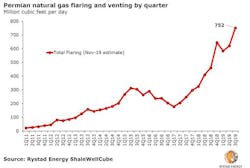Flaring and venting of natural gas in the Permian basin in Texas and New Mexico reached an all-time high in this year’s third quarter, averaging more than 750 MMcfd, according to a preliminary analysis conducted by Rystad Energy.
“This represents a new all-time high. Oil production in the Permian basin is growing at an accelerated pace again, and we observe high, sustained levels of flaring and venting of associated gas in the basin,” says Artem Abramov, head of shale research at Rystad Energy.
Rystad Energy has been closely monitoring the level of natural gas flaring in the Permian since 2017. Their previous quarterly estimate suggested that basin-wide gas flaring averaged between 600 and 650 MMcfd during the 9-month period from the fourth quarter of 2018 through the second quarter of 2019.
The Permian basin has experienced a vast increase in natural gas flaring and venting at the wellhead in the recent years, driven by a combination of higher activity levels, more production from areas with less developed gas gathering infrastructure, and basin-wide takeaway capacity bottlenecks.
“The most recent increase in flaring is predominantly driven by the Delaware Texas portion of the basin, which accounted for more than 40% of basin-wide flaring and venting as of the third quarter of 2019,” Abramov said. “Northern Midland also saw a significant boost in new activity, which resulted in increased flaring of associated gas. The subbasin has basically returned to the record level of flaring seen in the fourth quarter of 2018.”
At a company level, Rystad Energy notes that several operators have reduced their flaring intensity over the past 12 months. “A significant number of operators have exhibited a clear downwards shift in flaring intensity in 2019. Yet there are other examples of a recent increase in flaring intensity, which are primarily represented by some operators active in the Eastern Midland basin,” Abramov observed.
